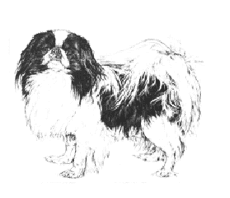Japanese Chin
General Information - Japanese Chin

Group:
Toy
Size:
small
Lifespan:
12-14 years
Exercise:
very little
Grooming:
moderate
Trainability:
moderate
Watchdog ability:
very high
Protection ability:
very low
Area of Origin:
Japan
Date of Origin:
ancient times
Other Names:
Japanese Spaniel
Original Function:
Lapdog
History
Despite its name, the Japanese Chin is actually of ancient Chinese origin, probably sharing a close relationship with the Pekingese. Like the Pekingese, the Chin was kept by Chinese aristocracy, and sometimes presented as a gift to visiting nobility. Different stories exist about how it arrived in Japan: Zen Buddhist teachers may have brought the breed sometime after A.D. 520, a Korean prince may have taken some to Japan in AD 732 or a Chinese emperor may have presented a pair to a Japanese emperor about a thousand years ago. However it got there, it gained great favour with the Japanese imperial family and was kept as a lap dog and ornament; some particularly small Chins were reportedly kept in hanging "bird" cages. Portuguese sailors first traded with Japan in the 16th century and may have been the first to bring Chins to Europe. However, the first official record of Chins coming to Europe was in 1853, when Commodore Perry presented a pair from his trip to Japan to Queen Victoria. In the succeeding years, traders brought back many more Chins, selling them in Europe and America.
Temperament
The Japanese Chin is a devoted companion, relishing a warm lap as much as a boisterous game. It is sensitive and willing to please, tending to shadow its owner. It is a friend to all: strangers, dogs and pets. Its playfulness and gentleness make it a good child’s companion for equally gentle children. The breed has been described as almost catlike-some even climb.
Upkeep
The Japanese Chin is lively but small enough that its exercise needs can be met with a short walk, romp or game. This is not a breed that can live outside. It does not do well in hot humid weather. Some Chins tend to wheeze. The long coat needs combing twice weekly.
Japanese Chin
A breed standard is the guideline which describes the ideal characteristics, temperament, and appearance of a breed and ensures that the breed is fit for function with soundness essential. Breeders and judges should at all times be careful to avoid obvious conditions and exaggerations, as well as being mindful of features which could be detrimental in any way to the health, welfare or soundness of this breed.
Breed Standard - Japanese Chin
 Characteristics:
Characteristics: The Japanese Chin is a lively little dog of dainty appearance, smart compact carriage and profuse coat. These dogs should be essentially stylish in movement, lifting the feet high when in motion carrying the tail, which is heavily feathered, closely curved or plumed over the back.
Head: Large but in proportion to size of dog, broad skull rounded in front, rounded between ears but in no way domed.
Nostrils: Should be large and black, except in the case of the red and white where the colour can be the same as the markings.
Eyes: Should be large, dark, set far apart. It is desirable that the white shows in the inner corners, this gives the Japanese Chin that characteristic look of astonishment (wrongly called squint) which should on no account be lost.
Muzzle: Muzzle very short and wide and well cushioned, i.e. upper lips rounded on each side of nostrils and mouth level.
Ears: Small, set wide apart and high on the head, carried slightly forward, V:shaped and well feathered.
Neck: Moderate length held up proudly.
Body: Should be squarely and compactly built, wide in chest, “cobby” in shape. The length of the dog’s body should be equal to its height at the withers.
Forequarters: Legs straight, and bone fine, giving them a slender appearance, well feathered to the feet.
Hindquarters: Straight viewed from behind, good turn of stifle, profusely feathered from the back of the thighs.
Feet: Should be slender and hare shaped, feathered at tips.
Tail: Set high on a straight back, profusely feathered, closely curved or plumed over the back.
Coat: Profuse coat, long soft and straight of silky texture. Absolutely free from curl or wave, not too flat, having a tendency to stand out especially at the frill of the neck.
Colour: Black and white or red and white. Red includes all shades, sable brindle, lemon or orange. The brighter and clearer the red the better. Colour evenly distributed on the cheeks and ears, and as patches on the body. Not too heavily marked desirable. White should be clear, not flecked.
Size: The daintier they are the better, providing type, quality and soundness are not sacrificed. As a guide suggested size 1.8 to 3.2 kg. (4-7 lbs).
Faults: Flying ears, wry mouth, tongue showing, tri-colour.
Note: Male animals should have two apparently normal testicles fully descended into the scrotum.
DNZ No 132
Copyright Dogs New Zealand
01 Jan 2002
Any departure from the foregoing points should be considered a fault and the seriousness with which the fault should be regarded should be in exact proportion to its degree and its effect upon the health and welfare of the dog and on the dog’s ability to perform its traditional work.




